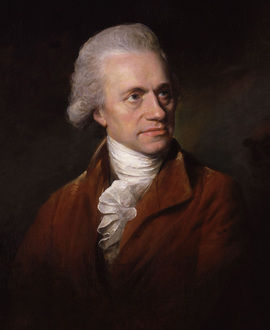Herschel's Experiment
How do you discover a kind of light that our eyes cannot see? Like so many revolutions in science, it was an unexpected result in a measurement that is so simple, anyone can easily repeat it on a sunny day using common materials.
Sir Frederick William Herschel (1738-1822) was born in Hanover, Germany and became well known as both a musician and as an astronomer. He moved to England in 1757 and, with his sister Caroline, constructed telescopes to survey the night sky. Their work resulted in several catalogs of double stars and nebulae. Herschel is famous for his discovery of the planet Uranus in 1781, the first new planet found since antiquity.
Herschel made another dramatic discovery in 1800. He wanted to know how much heat was passed through the different colored filters he used to observe sunlight. He noted that filters of different colors seemed to pass different amounts of heat. Herschel thought that the colors themselves might be of varying temperatures, so he devised a clever experiment to investigate his hypothesis.

He directed sunlight through a glass prism to create a spectrum (the rainbow created when light is divided into its colors) and then measured the temperature of each color. Herschel used three thermometers with blackened bulbs (to better absorb heat) and, for each color of the spectrum, placed one bulb in a visible color while the other two were placed beyond the spectrum as control samples.
As Herschel measured the individual temperatures of the violet, blue, green, yellow, orange, and red light, he noticed that all of the colors had temperatures higher than the controls. Moreover, he found that the temperatures of the colors increased from the violet to the red part of the spectrum. After noticing this pattern Herschel decided to measure the temperature just beyond the red portion of the spectrum in a region where no sunlight was visible. To his surprise, he found that this region had the highest temperature of all.
The prefix infra means below.
Herschel performed additional experiments on what he called "calorific rays" (derived from the Latin word for heat) beyond the red portion of the spectrum. He found that they were reflected, refracted, absorbed and transmitted in a manner similar to visible light. What Herschel had discovered was a form of light (or radiation) beyond red light, now known as infrared radiation. Herschel's experiment was important because it marked the first time that someone demonstrated that there were types of light that we cannot see with our eyes.
Beyond the Infrared
Herschel's discovery set the stage for our expanded understanding of the full spectrum of light.
In 1801 the scientist Johann Wilhelm Ritter was intrigued by Herschel's discovery of an invisible form of light beyond the red portion of the spectrum, Ritter decided to conduct experiments to determine if invisible light existed beyond the violet end of the spectrum as well. He experimented with chemicals that reacted to exposure with sunlight and found that light also seemed to extend beyond the violet part of the spectrum.
Ritter used the term "chemical rays" to describe this new kind of light, but today we know it as ultraviolet.
These first steps opened the doors to exploring the full spectrum of light which also includes gamma rays, x-rays, microwaves, and radio.
Published: 02 August, 2013


